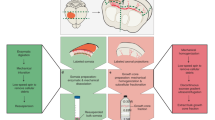Abstract
Retinal ganglion cell (RGC) axon regeneration in mammals can be stimulated through gene knockouts, pharmacological agents, and biophysical stimulation. Here we present a fractionation method to isolate regenerating RGC axons for downstream analysis using immunomagnetic separation of cholera toxin subunit B (CTB)-bound RGC axons. After optic nerve tissue dissection and dissociation, conjugated CTB is used to bind preferentially to regenerated RGC axons. Anti-CTB antibodies crosslinked to magnetic sepharose beads are used to isolate CTB-bound axons from a nonbound fraction of extracellular matrix and neuroglia. We provide a method of verifying fractionation by immunodetection of conjugated CTB and the RGC marker, Tuj1 (β-tubulin III). These fractions can be further analyzed with lipidomic methods, such as LC–MS/MS to gather fraction-specific enrichments.
Access this chapter
Tax calculation will be finalised at checkout
Purchases are for personal use only
Similar content being viewed by others
References
Park KK, Liu K, Hu Y et al (2008) Promoting axon regeneration in the adult CNS by modulation of the PTEN/mTOR pathway. Science 322(5903):963–966. https://doi.org/10.1126/science.1161566
Trzeciecka A, Carmy T, Hackam AS et al (2019) Lipid profiling dataset of the Wnt3a-induced optic nerve regeneration. Data Brief 25:103966. https://doi.org/10.1016/j.dib.2019.103966
Trzeciecka A, Stark DT, Kwong JMK et al (2019) Comparative lipid profiling dataset of the inflammation-induced optic nerve regeneration. Data Brief 24:103950. https://doi.org/10.1016/j.dib.2019.103950
Arcuri J, Liu Y, Lee RK et al (2020) Lipid profile dataset of optogenetics induced optic nerve regeneration. Data Brief 31:106001. https://doi.org/10.1016/j.dib.2020.106001
Mesmin C, van Oostrum J, Domon B (2016) Complexity reduction of clinical samples for routine mass spectrometric analysis. Proteomics Clin Appl 10(4):315–322. https://doi.org/10.1002/prca.201500135
Picotti P, Aebersold R, Domon B (2007) The implications of proteolytic background for shotgun proteomics. Mol Cell Proteomics 6(9):1589–1598. https://doi.org/10.1074/mcp.M700029-MCP200
Hu C, Duan Q, Han X (2020) Strategies to improve/eliminate the limitations in shotgun lipidomics. Proteomics 20(11):e1900070. https://doi.org/10.1002/pmic.201900070
Smith PD, Sun F, Park KK et al (2009) SOCS3 deletion promotes optic nerve regeneration in vivo. Neuron 64(5):617–623. https://doi.org/10.1016/j.neuron.2009.11.021
Belin S, Nawabi H, Wang C et al (2015) Injury-induced decline of intrinsic regenerative ability revealed by quantitative proteomics. Neuron 86(4):1000–1014. https://doi.org/10.1016/j.neuron.2015.03.060
Baldauf KJ, Royal JM, Hamorsky KT et al (2015) Cholera toxin B: one subunit with many pharmaceutical applications. Toxins (Basel) 7(3):974–996. https://doi.org/10.3390/toxins7030974
Benady A, Freidin D, Pick CG et al (2018) GM1 ganglioside prevents axonal regeneration inhibition and cognitive deficits in a mouse model of traumatic brain injury. Sci Rep 8(1):13340. https://doi.org/10.1038/s41598-018-31623-y
Author information
Authors and Affiliations
Corresponding author
Editor information
Editors and Affiliations
Rights and permissions
Copyright information
© 2023 The Author(s), under exclusive license to Springer Science+Business Media, LLC, part of Springer Nature
About this protocol
Cite this protocol
Meehan, S.D., Bhattacharya, S. (2023). Retinal Ganglion Cell Axon Fractionation. In: Udvadia, A.J., Antczak, J.B. (eds) Axon Regeneration. Methods in Molecular Biology, vol 2636. Humana, New York, NY. https://doi.org/10.1007/978-1-0716-3012-9_3
Download citation
DOI: https://doi.org/10.1007/978-1-0716-3012-9_3
Published:
Publisher Name: Humana, New York, NY
Print ISBN: 978-1-0716-3011-2
Online ISBN: 978-1-0716-3012-9
eBook Packages: Springer Protocols




